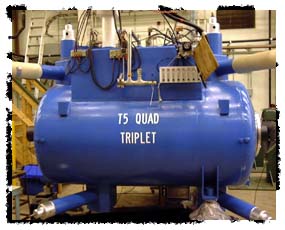Summer 1999 · Department Homepage

NSCL
Cyclotron upgrade commences:
Coupling the Cyclotrons
Orilla
McHarris
 The
NSCL is now in the process of an
upgrade which will dramatically increase its capability by coupling the
two existing superconducting cyclotrons (K500 and K1200) and by replacing
the existing fragment separator (A1200) with one of increased capacity
(A1900).
The
NSCL is now in the process of an
upgrade which will dramatically increase its capability by coupling the
two existing superconducting cyclotrons (K500 and K1200) and by replacing
the existing fragment separator (A1200) with one of increased capacity
(A1900).
The coupling of the cyclotrons will provide dramatic increases in the primary beam intensity, as well as increasing the energy of heavy ions, permitting a wide variety of experimental programs to be undertaken which are presently not feasible. The upgraded facility will provide a unique resource to the worldwide nuclear science community by filling a need for both stable and radioactive ion beams in an interesting and nearly unique energy domain. The high energies (90 MeV/nucleon for uranium) are an excellent match to the needs for studies of heated, compressed nuclear matter. The complementary aspects of the high intensity and low emittance for lighter ions are an excellent match to the needs of the growing radioactive ion beam field, as they provide very intense, good-quality secondary beams produced in fragmentation at a production target.
The K500 cyclotron was completed in 1982 as the world’s first superconducting cyclotron, and as such was prototypical. The K500 had known reliability problems, undesirable magnetic field harmonics, and a relatively poor beam chamber vacuum. When the K1200 was later constructed, the lessons learned were applied, and the K1200 has significantly better attributes and a notable reliability of >90%. The K500 was first completely disassembled to make significant improvements to the cyclotron vacuum system. It was thereafter reassembled, and, guided by magnetic field maps, yoke steel modifications were made which reduced the undesirable field harmonics. The K500 rf system was replaced with one following the K1200 system design.
A magnetic system will transport beam from the K500 to the K1200. Installation of a mechanism to position the thin carbon stripping foils and improvement of the robustness of the extraction septa are the primary K1200 upgrade activities. (The capability to operate the K1200 in stand-alone mode will be retained.) The foil mechanism inside the cyclotron has been designed and construction initiated. The design of a loading system, which will allow foil replacement without interrupting the cyclotron vacuum, is in progress. A program to improve the K1200 extraction system was begun about two years ago and is planned to continue until the coupled cyclotron commissioning in the year 2001. A major element of the upgrade is a new fragment separator with an increased rigidity and greater collection efficiency. The A1900 will use 24 quadrupoles configured in eight triplet packages, and four 45° dipoles in a reverse bend geometry so that incoming and outgoing beams are coaxial.
The A1900 magnets
are energized by superconducting coils. Beginning in mid 1999, the K1200-supported
experimental nuclear physics program will be stopped for a period of approximately
18 months to reconfigure the facility and install new equipment. A six
months commissioning period is planned in 2001with project completion
scheduled during that year. The coupled cyclotron project is jointly funded
by Michigan State University and the National Science Foundation.
Online newsletter maintained by David McCreery
